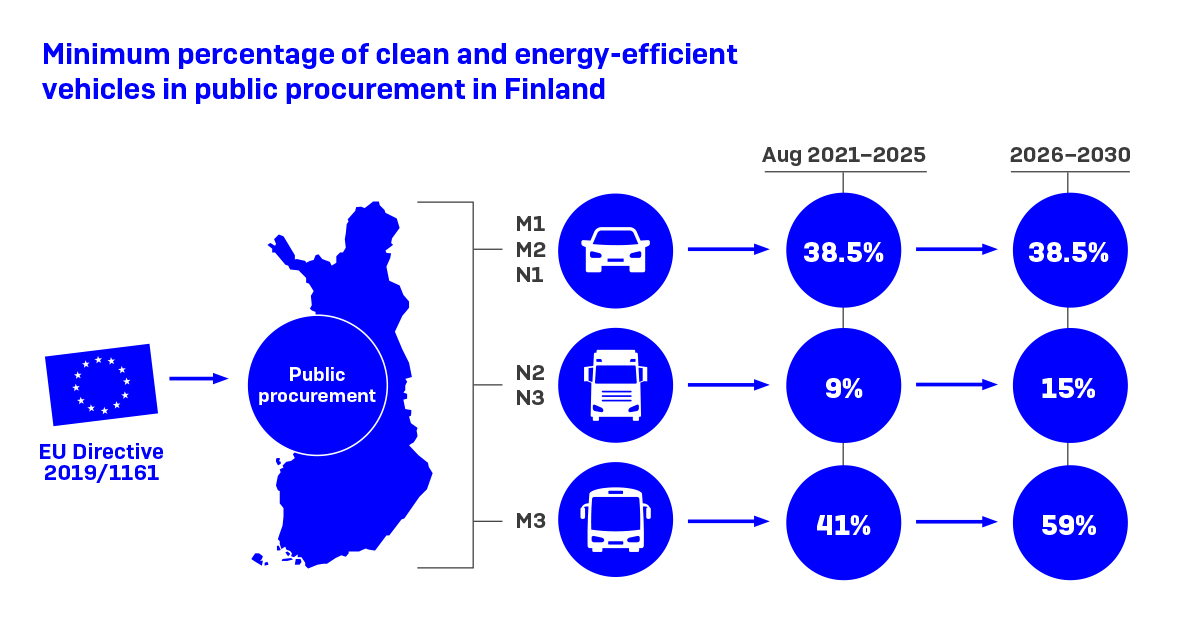Preparation of legislation on public vehicle procurement proceeds – low-emission vehicles and services to Finland

A working group is preparing the implementation of the EU Directive concerning the promotion of clean vehicles in public procurement in Finland. The aim is to increase the proportion of zero- and low-emission vehicles in public procurement concerning vehicles and transport services. A study on the matter was completed just recently, and now the working group will use this to assess different options to draft the national legislation in a way that is cost-efficient and takes regional differences into account.
The study examined the volumes of public procurement and regional differences in this, as well as the distribution infrastructure of alternative fuels. Alternatives ways are proposed how Finland could increase the proportion of a clean vehicle fleet and services in the transport sector. The study was commissioned by the Ministry of Transport and Communications and conducted by Ramboll Finland.
Clean vehicles have an important role in reducing greenhouse gas emissions and reaching the targets set in the Paris Climate Change Agreement. Transport accounts for about a quarter of total emissions within the EU, and it is the only sector in the EU area where emissions are still growing.
Public procurement offers excellent opportunities to renew vehicle technology and reduce emissions from the transport sector. The new legislation will mean that the use of fossil fuels will be decreasing, while there will be a growing demand for alternative fuels such as electricity, gas and biofuels. The requirements set in the Directive will also contribute to achieving the climate objectives included in the Government Programme.
Which public procurement operations will the legislation apply to?
- The requirements concern the procurement of vehicles and services in the public sector.
- The requirements apply when a contracting entity buys, hires, leases, hire-purchases or acquires certain transport services, including waste collection or postal services.
- The Directive only applies to new procurement operations or contracts where the value exceeds the thresholds set in the EU procurement legislation.
What is a clean passenger car or van (M1, M2, N1)?
- CO2 emissions no more than 50 g/km until the end of 2025 and 0 g/km as from 2026. In practice this means full electric cars and, until the end of 2025, plug-in hybrids.
- The quantitative obligation set for Finland is that 38.5% of the new passenger cars or vans procured must be clean.
What is a clean heavy duty vehicle (N2, N3)?
- A vehicle that runs with biofuel, electricity, gas or hydrogen.
- The quantitative obligation set for Finland is that 9% of the new heavy duty vehicles procured between August 2021 and 2025 and 15% of those procured as from 2026 must be clean.
What is a clean bus (M3)?
- A vehicle that runs with biofuel, electricity, gas or hydrogen.
The quantitative obligation set for Finland is that 41 % of the new buses procured between August 2021 and 2025 and 59 % of those procured as from 2026 must be clean.
What is excluded from the scope of the Directive?
The Directive does not apply to coaches used in long-distance transport or charter services or e.g. to vehicles used in agriculture and forestry or to two or three-wheel vehicles. In addition, a Member State may exempt certain vehicles from the requirements laid down in the Directive. These include emergency vehicles and vehicles used by the armed forces or on construction sites.
What are the next steps?
The Ministerial Working Group on Climate and Energy Policy will discuss the content of the new legislation during the spring. The legislative proposal will be circulated for comment and a public consultation will be held on it in May-June 2020. The requirements of the Directive will be applicable as from August 2021.
Inquiries
Eleonoora Eilittä, Senior Specialist, tel. +358 295 34 2089, eleonoora.eilitta(at)lvm.fi, Twitter @EleonooraE
Selvitys puhtaan kaluston direktiivin kustannustehokkaasta kansallisesta täytäntöönpanosta (A study on cost-efficient national implementation of the Clean Vehicle Directive; in Finnish)
Gateway for Information on Government projects (in Finnish)
European Commission: Clean Vehicles Directive



